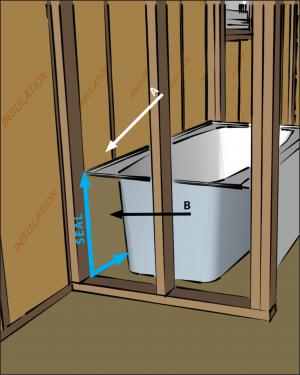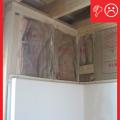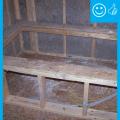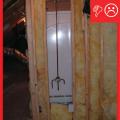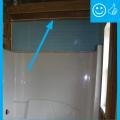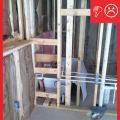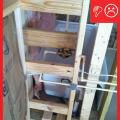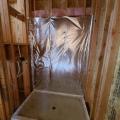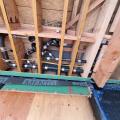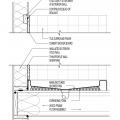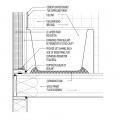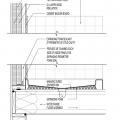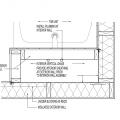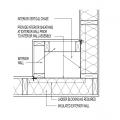Scope
Install an air barrier behind showers and tubs installed on exterior walls.
- Install insulation without misalignments, compressions, gaps, or voids in all exterior wall cavities behind tubs and showers.
- Cover the wall cavities with a rigid air barrier or other supporting material to prevent cavity insulation from sagging and to create a continuous thermal barrier.
- Seal all seams, gaps, and holes in the air barrier with caulk or foam before tub/shower installation. Rigid air barrier materials for use behind showers and tubs include fiber-cement, fiber-reinforced gypsum, glass mat gypsum, or fiber mat-reinforced cementitious backer panels. See the guide [WM.4.2] Cement Board Installed behind Tile and Panel Tub and Shower Enclosures for more information.
See the Compliance Tab for links to related codes and standards and voluntary federal energy-efficiency program requirements.
Description
When tubs and showers are installed on exterior walls, builders may forget to insulate and air seal the exterior wall behind the tub or shower surround. Neglecting to insulate and air seal here can result in significant heat loss and complaints from homeowners about tubs, showers, and bathrooms that are always cold. The insulation behind the tub or shower should be equivalent to the insulation in the rest of the exterior walls and should be covered with an air barrier of cement backer board, rigid foam insulation, or non-paper-faced drywall that is sealed at the edges and seams to provide a continuous air seal. Any type of insulation may be installed as long as it completely fills the void and will be in full contact with the air barrier. These materials may be installed by insulators, framers, or subcontractors or vendors hired specifically to install the tub or shower. This task should be included in the contract for the appropriate trade depending on the workflow at specific job sites.
Air barrier effectiveness is measured at the whole-house level. High-performance branding programs and the IECC code require that builders meet specified infiltration rates at the whole-house level. See the “compliance” tab for these specified infiltration rates.
How to Install a Fully Aligned Air Barrier on the Walls behind Showers and Tubs
- Install exterior rigid foam sheathing. Fill the entire wall cavity with insulation to the R-value required by local code or higher.
- Install 2x4 blocking between the wall studs, if needed, to support the air barrier.
- Cut cement board, fiber cement board, paperless gypsum board, Thermo-Ply, or other thin barrier material to size to cover area behind tub (see Figures 1 and 2). Apply a thick bead of caulk to the surface of exposed studs, wood blocking, and bottom plate. Nail or screw the thin-profile air barrier material to the studs. Note: moisture-resistant gypsum board or “green board” is not recommended. Cement board is not waterproof; it must be coated with a fluid-applied waterproofing, or a water-resistive barrier must be applied behind it that allows drainage (See the guide Cement Board Installed Behind Tile and Panel Tub and Shower Enclosures).
- Use caulk or foam to seal seams and any holes made through the air barrier material.
- Install the new tub.
- Block holes around the tub drain with sheet goods and spray foam.
- Finish the walls by installing fiberglass wall panels or tiling the surface.


Success
Blower door testing conducted as part of building performance testing may help indicate whether air leakage behind a bathtub or shower has been successfully sealed. An infrared camera can be used in conjunction with the blower door testing to inspect the insulation and to detect air leakage behind the tub or shower, especially if the tub or shower is installed on an exterior wall. Insulation and air barrier installation should be inspected by the site supervisor.
Typical R-values for common insulation materials are summarized in this table, which also identifies the vapor retarder classification for each insulation.
Climate
The map in Figure 1 shows the climate zones for states that have adopted energy codes equivalent to the International Energy Conservation Code (IECC) 2009, 12, 15, and 18. The map in Figure 2 shows the climate zones for states that have adopted energy codes equivalent to the IECC 2021. Climate zone-specific requirements specified in the IECC are shown in the Compliance Tab of this guide.


Training
CAD
Compliance
More
More Info.
Access to some references may require purchase from the publisher. While we continually update our database, links may have changed since posting. Please contact our webmaster if you find broken links.
The following authors and organizations contributed to the content in this Guide.
Pacific Northwest National Laboratory
Building Science Corporation, lead for the Building Science Consortium (BSC), a DOE Building America Research Team
Sales
Fully Aligned Air Barriers = Whole-House Draft Barrier
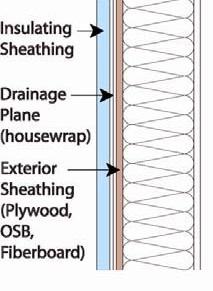
A whole-house draft barrier is a continuous layer of air-tight materials that block air leaks. This barrier can be integrated with other materials to also function as a water barrier, thermal barrier, and vapor barrier. For example, rigid foam insulation can be used to block thermal flow as well as air flow when seams are sealed with tape, caulk, adhesives, or liquid-applied sealants. Some rigid foams have an integrated water control layer as well. Additionally, drywall can serve as an interior air barrier when the seams are taped and spackled, and caulk, spray foam, or gaskets are used to seal around wiring, plumbing, and other penetrations. It also serves as the vapor barrier when finished with paint. Insulation should be in full contact with the air barrier layer.
